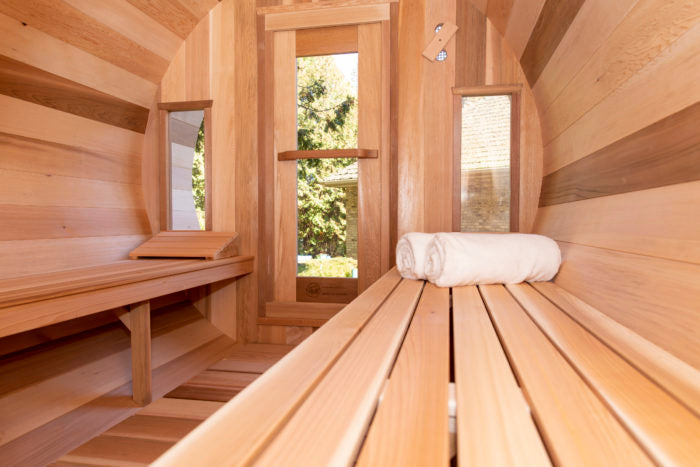The Main Principles Of Traditional Sauna
Table of ContentsTraditional Sauna Fundamentals ExplainedTraditional Sauna Can Be Fun For AnyoneThe Single Strategy To Use For Traditional SaunaTraditional Sauna Can Be Fun For Anyone
The majority of the weight lost in a sauna is water loss and is re-gained upon rehydrating. Without a doubt sauna can be an important part of a healthy weight loss program. To take a look at the distinctions between traditional and IR saunas, I will certainly separate these right into proven, academic, and produced differences.Thus, the best factor in the saunawhich goes to the ceiling directly over the sauna heateris commonly in between 185 and 190 F. Traditional Sauna. Claims that a typical sauna goes beyond 200 F is just not real and not applicable for electrical saunas offered in the US. The temperature level for a far-infrared sauna is normally set between 120 and 140 F; nonetheless, unlike the traditional sauna, the goal in and IR room is not to attain a high temperature
As a result of this, the temperature distinction is almost pointless, because profuse sweating leads to both sauna types, however the technique of heating the body is various. In an IR sauna the bather will feel hot and will certainly sweat profusely, however at much reduced temperature levels. Therefore, if the goal is to spend longer amount of times in the sauna, the IR sauna is a great choice.

The Main Principles Of Traditional Sauna
When the high temperature is accomplished, the components cycle on and off to preserve the high temperature level. Many conventional sauna individuals appreciate pouring water over the rocks to create steam to raise sauna humidity degrees. The advantages of pouring water over the rocks include: making the room much more comfortable, moistening the nasal passages, and enabling the use of aromatherapy by mixing crucial oils with the water.
In a far-infrared sauna, the warm front pass through the body to effectively warm the body and increase the body core temperature. To attain this increased temperature level, Far-infrared emitters develop infrared energy which is close to the very same wavelength as that which the body normally emitsoften referred to as the "Vital Range" of 7 to 14 microns), so the energy is well gotten by the body.
When the energy enters the body, it creates the body temperature to increase and eventually results in perspiration. In an infrared sauna it is very important for the emitters/heaters to remain on nearly constantly. Given that there is no mass of rocks to preserve warmth, the sauna will cool if the emitters shut off.
As pointed out above, the sauna bather in an infrared area intends to position himself before operating emitters to obtain maximum benefit from the heat. The home heating time for both rooms can be very different, depending upon how the spaces are made use of. For a standard sauna, a bather should enable 30-40 minutes for the area to attain a desired temperature level and to appropriately pre-heat the rocks.
Getting The Traditional Sauna To Work
A well built sauna will typically achieve a temperature level of 150-160 F in about 30-40 minutes (Traditional Sauna). For hotter temperatures, the area might require to warm for a longer period. Once the area achieves established temperature, the heater will certainly you could try here cycle on and off, normally operating concerning 50% of the time. The shielded wall surfaces and the heated rocks will maintain the room warm and at stable temperatures.
To some, 15 mins was "squandered" while the infrared energy heated more info here up the wood panels as opposed to heating up a body, while others locate a pre-heated area to be a lot more comfortable and believe a raised starting temperature is essential to begin perspiring. The length of suggested usage for each and every space is around the same (10-15 mins per session); nevertheless, due to the reduced air temperatures and the capability to really feel the effects of infrared warmth much faster than a standard sauna, it is not uncommon for an individual to spend an overall of 20-30 minutes in an infrared sauna.
Traditional saunas often tend to be larger (thus utilize more electrical power) than infrared saunas, although standard saunas are definitely offered in one and two person sizes too. For a two-person conventional sauna, 5x6 or 5x7 dimension is most preferred. The leading bench can conveniently seat 2 or 3 individuals and is also long sufficient to relax during the sauna session.


The typical expense per kWH of electrical energy in the U.S. is around $0.11, so a 4.5 kW heating unit will set you back approximately $.50 to compete one hour, if the heater runs continuously for site one hour. Typically a sauna heater will compete 75% of the initial hour and 50% of succeeding hours on considering that the aspects cycle once the set temperature level is accomplished.
Getting My Traditional Sauna To Work
A 2 individual far-infrared space is usually physically smaller sized than a typical sauna, usually concerning 4' x 4' or smaller. The IR heater is typically 1.5-1.7 kW making use of a 120 volt 15 amp plug-in service. Since the room can be used sooner than a sauna room, we will assume the space is utilized for to of an hour consisting of warmth up time.
Finally, there is a rarely discussed distinction in the social experience between both spaces. While our society has actually shed some of the social benefit of the conventional sauna experience, it can be very socially rewarding. From family time in the sauna, to heart-felt conversations with significant others, to sauna partiesthe typical sauna experience can cause intimate mingling.
Most greater end infrared spaces consist of colored light therapy, audio systems and full-glass fronts.